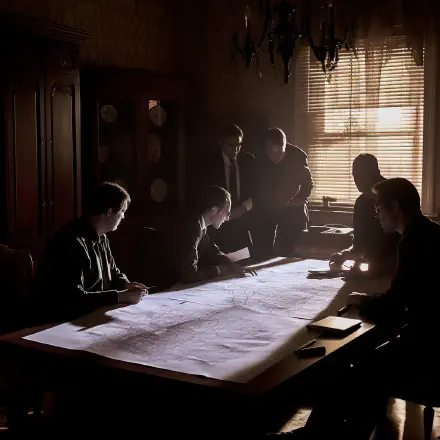
Introduction
Welcome to “Humorous Tales of Organizational Thinking Fails”! In this blog, we’ll be sharing some of the most ridiculous and hilarious examples of bad organizational thinking that have left us scratching our heads. But it’s not all just for laughs - we’ll also be discussing the importance of recognizing and learning from these fails in order to improve our own organizational practices.
Have you ever experienced a truly baffling decision or policy in your workplace? Perhaps you’ve been told to save the environment by using fewer coffee cups, only to find that the alternative was even more wasteful. Or maybe you’ve sat in meeting after meeting where nothing was accomplished because the manager insisted on including every single person’s opinion.
We’re here to commiserate with you, and to remind you that even the biggest organizational fails can have a bright side. So sit back, relax, and get ready to chuckle at some of the absurdities of workplace decision-making.
The Tale of the Misplaced Coffee Cups
Have you ever heard of an initiative that seemed like a good idea at first, only to realize it was a complete disaster once it was implemented? Well, that’s exactly what happened at the coffee-loving company I used to work for.
The management team decided to encourage employees to be environmentally conscious by providing only one coffee cup per person. The logic was simple: if employees had only one cup, they would be more likely to wash, reuse, and remember to take it home at the end of the day.
But, as with many things, the implementation fell flat. Employees started hoarding cups, hiding them in their drawers and lockers. Others would bring their own cups from home, but it was the same story: cups would pile up on desks, counters, and even in the sink. It was a mess, quite literally.
To make matters worse, employees spent more time hunting for a cup than actually working. They would interrupt their colleagues mid-task to ask if they had taken, borrowed, or seen a cup. And once they found a cup, they would guard it with their lives, even if they didn’t need to use it right away.
In the end, the initiative had the exact opposite effect on productivity and morale. Instead of being environmentally conscious, employees were simply annoyed, frustrated, and confused.
Lesson learned: Sometimes, the best intentions can lead to the worst outcomes. And sometimes, it’s better to ask for feedback before implementing a new policy.
The Case of the Overly Inclusive Meeting
In an effort to be inclusive and collaborative, a manager at a large corporation invited every possible stakeholder to a meeting to make a decision on a new project. What resulted was an excruciatingly long and unproductive meeting that left everyone feeling drained.
The Never-Ending Meeting
The meeting began with a simple agenda, but it quickly spiraled out of control as each stakeholder felt obligated to voice their opinion. Hours went by as the group struggled to come to a consensus.
“It was like watching a train wreck in slow motion,” said one attendee. “We were all getting frustrated, but no one wanted to be the one to call it quits.”
The Cost of Over Inclusivity
The cost of such inclusivity was more than just lost hours. As the meeting dragged on, attendees missed other scheduled meetings and appointments. In addition, the inability to make a decision and move forward caused missed deadlines and lost opportunities.
“It was one of the most frustrating experiences of my career,” said another attendee. “I left the meeting feeling exhausted and defeated.”
A Lesson Learned
While inclusivity is important, this meeting taught the company that there needs to be a balance. Including too many people in a decision-making process can result in chaos, and it’s important to have clear guidelines for who should be involved.
“We learned that sometimes it’s better to have a small, focused group rather than trying to please everyone,” the manager reflected. “Moving forward, we will be more intentional about who we invite to meetings and how we structure them.”
The IT Disaster of Updating Software
Updating software is a common practice in any organization. However, when it goes wrong, it can bring an entire company to its knees. Such was the case for our company.
We had just purchased an upgraded software version and decided to update our system during the weekend when no one was working. However, what we thought was a simple software update turned into a complete disaster.
When we came back to work on Monday, no one could log into their accounts, databases were corrupted, and critical systems were down. Chaos ensued, and our IT department was scrambling to fix the issue.
Attempts to Workaround the Problem
As the IT team was working on a solution, employees tried to work around the problem. Some of them tried to use outdated software versions, while others resorted to using personal software to make up for the lost productivity.
This improvisation only added to the chaos. Different users had different versions of software and incompatible files could not be opened or shared. It was like working in the wild west of tech.
The Aftermath
Our productivity was hampered for weeks, and we lost vital data. The cost of hiring outside experts to fix the problem was significant. But the worst thing was the entire IT team was blamed for the fiasco.
Fortunately, we learned a valuable lesson. From then on, we made sure to test software updates on a small scale before rolling it out to the entire organization. We also created a comprehensive backup and recovery plan in case of any future disasters.
As the saying goes, “If you fail to plan, you plan to fail.” In this case, we were lucky enough to learn from a mistake that could have had a much more devastating outcome.
Blockquote: “There are one hundred men hacking at the branches of evil to one who is striking at the root.” -Henry David Thoreau
Remember, learning from mistakes is essential in any organization and a plan is crucial in avoiding organizational thinking fails.
The Communication Breakdown
In today’s fast-paced work environment, communication is essential. But what happens when communication breaks down from the top-down? This can lead to confusion, delay, and frustration for employees.
Over Reliance on Email
One of the biggest culprits of communication breakdown in the workplace is an over-reliance on email. Sure, it’s convenient, but when important information is buried in an overflowing inbox, it’s easy to miss.
“I once missed a crucial deadline because the email got lost in a sea of spam,” says Jane, a former office manager. “It wasn’t until my boss asked me about it, that I realized what had happened.”
Choosing the Wrong Medium
Another problem is choosing the wrong medium for the message. For example, if a message is too complex or requires a discussion, using email may not be the best option. Instead, a face-to-face meeting or phone call may be more effective.
Lack of Clarity
In some cases, communication breakdown happens simply because the message isn’t clear. “I once received an email from my supervisor that said ‘Get it done ASAP.’ I had no idea what ‘it’ was or what ‘ASAP’ meant in this context,” says John, a former sales associate.
Solutions
So, what’s the solution? It’s important to establish clear communication protocols within the organization, taking into account the type of message, the receiver, and the urgency. This may involve integrating different communication channels and establishing rules around their use.
“We recently implemented a ’no email after 6 pm’ rule to avoid burnout and encourage employees to disconnect,” says Sarah, a senior HR manager. “We’ve also started using instant messaging and video conferencing for quick questions and feedback.”
In conclusion, don’t underestimate the importance of clear and effective communication in the workplace. Take proactive steps to avoid breakdowns before they happen.
The Tale of the Overburdened Employee
At XYZ Corporation, management believed in pushing the limits of their employees to encourage growth and development. They wanted their staff to take on more responsibility to show they were capable of handling it. It all seemed well and good in theory, but in practice, it resulted in disastrous consequences.
One employee, in particular, we’ll call her Jane, took on every opportunity thrown her way to prove herself. She wanted to be seen as a valuable asset to the company and was determined to make a name for herself. However, her eagerness and willingness to take on every task soon became the demise of her productivity and overall well-being.
Jane went from being a star employee to one who was bogged down by endless meetings, supervising junior staff, and being on-call all the time. It was as if the company believed Jane had no personal life or work-life balance. It all came to a head when the company had an urgent project that needed to be completed on a tight deadline. They leaned on Jane heavily to get the job done and made unrealistic demands of her time, which eventually resulted in a burnout.
She ended up taking time off due to exhaustion, highly stressed, and demotivated. The company had not taken into account that pushing their employees to their limits may mean that they become liabilities rather than assets. It was clear that the company’s strategy had not been thought through carefully, and they had not taken into consideration the well-being of their employees.
As a result of Jane’s experience, the company made some changes to their approach. They began to take a more holistic approach to employee development that considers the skill sets of each team member and their roles within the company. They also stressed the importance of work-life balance.
In conclusion, organizational thinking fails can be detrimental to the growth and development of companies and their employees. It is vital for companies to recognize that being overly ambitious in pushing their employees to take on too much responsibility can have negative long-term effects, which may not show up in the short-term. The burnout of their employees can have a harmful impact on the overall productivity of the company. Therefore, it is essential to find a balance between the growth of the company and the well-being of its employees.
Conclusion
Now that we’ve had a good laugh at some of the mishaps caused by bad organizational thinking, let’s take a moment to recognize the importance of learning from these failures. By understanding what went wrong and why, we can avoid making the same mistakes in our own organizations.
It’s crucial to remember that these stories are not meant to shame or ridicule anyone, but rather to highlight the absurdities of organizational thinking and encourage improvement. We all make mistakes, but by acknowledging and learning from them, we can create a more productive and positive work environment.
We’d love to hear your own tales of organizational thinking fails in the comments section below. Sharing our stories not only allows us to learn from each other’s experiences but also reminds us that we’re not alone in our struggles.
Remember, laughter is the best medicine, so don’t forget to take some time to appreciate the humor in life and work. Thanks for reading, and don’t forget to subscribe to our newsletter for more content like this!
Final Thoughts
As we close this chapter on the humorous tales of organizational thinking fails, let’s take a moment to reflect on what we’ve learned. We’ve seen how good intentions can go awry and how even the most well-thought-out plans can result in chaos. But more importantly, we’ve learned the value of humility and the importance of taking the time to listen to those on the front lines.
So, let us all remember to approach our work with an open mind, a willingness to learn, and of course, a good sense of humor. And if you have any tales of your own to share, please do so in the comments below!
In the words of Dwight D. Eisenhower, “What is important is seldom urgent and what is urgent is seldom important.” So let’s all take a breath, have a chuckle, and remember to prioritize what truly matters.
And if you enjoyed this blog, be sure to subscribe to our newsletter for more humorous takes on the ups and downs of organizational life. Or check out our related posts on the importance of teamwork and effective communication. Thanks for reading!


